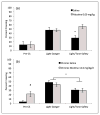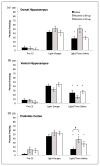Nicotine disrupts safety learning by enhancing fear associated with a safety cue via the dorsal hippocampus
- PMID: 28675115
- PMCID: PMC5755391
- DOI: 10.1177/0269881117695861
Nicotine disrupts safety learning by enhancing fear associated with a safety cue via the dorsal hippocampus
Abstract
Learned safety, a learning process in which a cue becomes associated with the absence of threat, is disrupted in individuals with post-traumatic stress disorder (PTSD). A bi-directional relationship exists between smoking and PTSD and one potential explanation is that nicotine-associated changes in cognition facilitate PTSD emotional dysregulation by disrupting safety associations. Therefore, we investigated whether nicotine would disrupt learned safety by enhancing fear associated with a safety cue. In the present study, C57BL/6 mice were administered acute or chronic nicotine and trained over three days in a differential backward trace conditioning paradigm consisting of five trials of a forward conditioned stimulus (CS)+ (Light) co-terminating with a footshock unconditioned stimulus followed by a backward CS- (Tone) presented 20 s after cessation of the unconditioned stimulus. Summation testing found that acute nicotine disrupted learned safety, but chronic nicotine had no effect. Another group of animals administered acute nicotine showed fear when presented with the backward CS (Light) alone, indicating the formation of a maladaptive fear association with the backward CS. Finally, we investigated the brain regions involved by administering nicotine directly into the dorsal hippocampus, ventral hippocampus, and prelimbic cortex. Infusion of nicotine into the dorsal hippocampus disrupted safety learning.
Keywords: Learned safety; backward conditioning; hippocampus; nicotine; prelimbic cortex.
Conflict of interest statement
The author(s) declared no potential conflicts of interest with respect to the research, authorship, and/or publication of this article.
Figures






References
-
- Benowitz NL. Cotinine as a biomarker of environmental tobacco smoke exposure. Epidemiol Rev. 1996;18:188–204. - PubMed
-
- Benowitz NL, Porchet H, Sheiner L, et al. Nicotine absorption and cardiovascular effects with smokeless tobacco use: Comparison with cigarettes and nicotine gum. Clin Pharmacol Ther. 1988;44:23–28. - PubMed
-
- Blanchard RJ, Blanchard DC. Crouching as an index of fear. J Comp Physiol Psychol. 1969;67:370–375. - PubMed
-
- Blechert J, Michael T, Vriends N, et al. Fear conditioning in post-traumatic stress disorder: Evidence for delayed extinction of autonomic, experiential, and behavioural responses. Behav Res Ther. 2007;45:2019–2033. - PubMed
Publication types
MeSH terms
Substances
Grants and funding
LinkOut - more resources
Full Text Sources
Other Literature Sources

